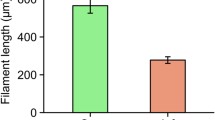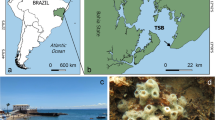Abstract
In this paper we describe the life history consequences of feeding Daphnia galeata with different food types in different concentrations. We fed the animals with four concentrations of two green algae Scenedesmus obliquus and Chlamydomonas globosa, given separately as well as in a 1:1 mixture. Growth, reproduction and condition of the animals and consequently the intrinsic rate of population increase, r, increased with the concentration of the food for all three experimental series. The life history parameters measured were lowest in the animals raised on C. globosa. Animals fed on S. obliquus showed higher values for r. We observed a distinct synergistic effect of the two algal species: growth, reproduction, condition and r were significantly higher for the animals raised on the mixed media as compared to the animals raised on the mono-algal media. We conclude that the two algal species represented complementary food resources.
Similar content being viewed by others
References
Ahlgren, G., L. Lundstedt, M. T. Brett & C. Forsberg, 1990. Lipid composition and food quality of some freshwater phytoplankton for cladoceran zooplankters. J. Plankton Res. 12: 809–818.
Boersma, M. & J. Vijverberg, 1994a. Possible toxic effects on Daphnia resulting from the green alga Scenedesmus obliquus. Hydrobiologia 294: 99–103.
Boersma, M. & J. Vijverberg, 1994b. The effect of preservation methods on the Carbon content of Daphnia. Arch. Hydrobiol. 130: 241–247.
Boersma, M. & J. Vijverberg, 1994c. Seasonal variations in the condition of two Daphnia species and their hybrid in a eutrophic lake: evidence for food limitation. J. Plankton Res. 16: 1793–1809.
Cowgill, U. M., K. I. Keating & I. T. Takahashi, 1985. Fecundity and longevity of Ceriodaphnia dubia/affinis in relation to diet at two different temperatures. J. Crust. Biol. 5: 420–429.
DeMott, W. R., Q. Z. Zhang & W. W. Carmichael, 1991. Effects of toxic cyanobacteria and purified toxins on the survival and feeding of a copepod and 3 species of Daphnia. Limnol. Oceanogr. 36: 1346–1357.
Duncan, A., W. Lampert & O. Rocha, 1985. Carbon weight on length regressions of Daphnia spp. grown at threshold food concentrations. Verh. int. Ver. Limnol. 22: 3109–3115.
Gliwicz, Z. M. & W. Lampert, 1990. Food thresholds in Daphnia species in the absence and presence of blue-green filaments. Ecology 71: 691–702.
Hanazato, T. & M. Yasuno, 1984. Growth, reproduction and assimilation of Moina macrocopa fed on Microcystis and/or Chlorella. Jpn. J. Ecol. 34: 195–202.
Hartmann, H. J. & D. D. Kunkel, 1991. Mechanisms of food selection in Daphnia. Hydrobiologia 225 (Dev. Hydrobiol. 71): 129–154.
Hessen, D. O. & E. van Donk, 1993. Morphological changes in Scenedesmus induced by substances released from Daphnia. Arch. Hydrobiol. 127: 129–140.
Jamieson, C. D., 1980. Observations on the effect of diet and temperature on rate of development of Mesocyclops leuckarti (Claus) (Copepods, Cyclopoida). Crustaceana 38: 145–154.
Kerfoot, W. C. & K. L. Kirk, 1991. Degree of taste discrimination among suspension-feeding cladocerans and copepods — Implications for detritivory and herbivory. Limnol. Oceanogr. 36: 1107–1123.
Lampert, W., 1977. Studies on the carbon balance of Daphnia pulex de Geer as related to environmental conditions. II. The dependence of carbon assimilation on animal size, temperature, food concentration and diet species. Arch. Hydrobiol. Suppl. 48: 310–335.
Lewis, M. A. & A. W. Maki, 1981. Effects of water hardness and diet on productivity of Daphnia magna Straus in laboratory culture. Hydrobiologia 85: 175–179.
Lundstedt, L. & M. T. Brett, 1991. Differential growth rates of 3 cladoceran species in response to mono-algal and mixed-algal cultures. Limnol. Oceanogr. 36: 159–165.
Meyer, J. S., C. G. Ingersoll, L. L. McDonald & M. S. Boyce, 1986. Estimating uncertainty in population growth rates: Jacknife vs Bootstrap techniques. Ecology 67: 1156–1166.
Müller-Navarra, D., 1993. Quantifizierung von Nahrungsqualität für herbivores Zooplankton. Thesis, University of Kiel, 137 pp.
Pennings, S. C., M. T. Nadeau & V. J. Paul, 1993. Selectivity and growth of the generalist herbivore Dolabella auricularia feeding upon complementary resources. Ecology 74: 879–890.
Roman, M. R., 1984. Utilization of detritus by the copepod, Acartia tonsa. Limnol. Oceanogr. 29: 949–959.
Rothhaupt, K. O., 1991. The influence of toxic and filamentous blue-green algae on feeding and population growth of the rotifer Brachionus rubens. Int. Rev. ges. Hydrobiol. 76: 67–72.
Salonen, K., 1979. A versatile method for the rapid and accurate determination of carbon by high temperature combustion. Limnol. Oceanogr. 24: 177–183.
Sterner, R. W., D. D. Hagemeier & W. L. Smith, 1993. Phytoplankton nutrient limitation and food quality for Daphnia. Limnol. Oceanogr. 38: 857–871.
Taub F. B. & A. M. Dollar, 1968. The nutritional inadequacy of Chlorella and Chlamydomonas as food for Daphnia pulex. Limnol. Oceanogr. 13: 607–617.
Tessier, A. J. & C. E. Goulden, 1982. Estimating food limitation in cladoceran populations. Limnol. Oceanogr. 27: 707–717.
Tilman, D., 1982. Resource competition and community structure. Princeton University Press, Princeton, NJ.
van Donk, E. & D. O. Hessen, 1993. Grazing resistance in nutrient-stressed phytoplankton. Oecologia 93: 508–511.
Vanni, M. J. & W. Lampert, 1992. Food quality effects on life history traits and fitness in the generalist herbivore Daphnia. Oecologia 92: 48–57.
Vijverberg, J., 1989. Culture techniques for studies on the growth, development and reproduction of copepods and cladocerans under laboratory and in situ conditions: a review. Freshwat. Biol. 21: 317–373.
Author information
Authors and Affiliations
Rights and permissions
About this article
Cite this article
Boersma, M., Vijverberg, J. Synergistic effects of different food species on life-history traits of Daphnia galeata . Hydrobiologia 307, 109–115 (1995). https://doi.org/10.1007/BF00032002
Issue Date:
DOI: https://doi.org/10.1007/BF00032002




